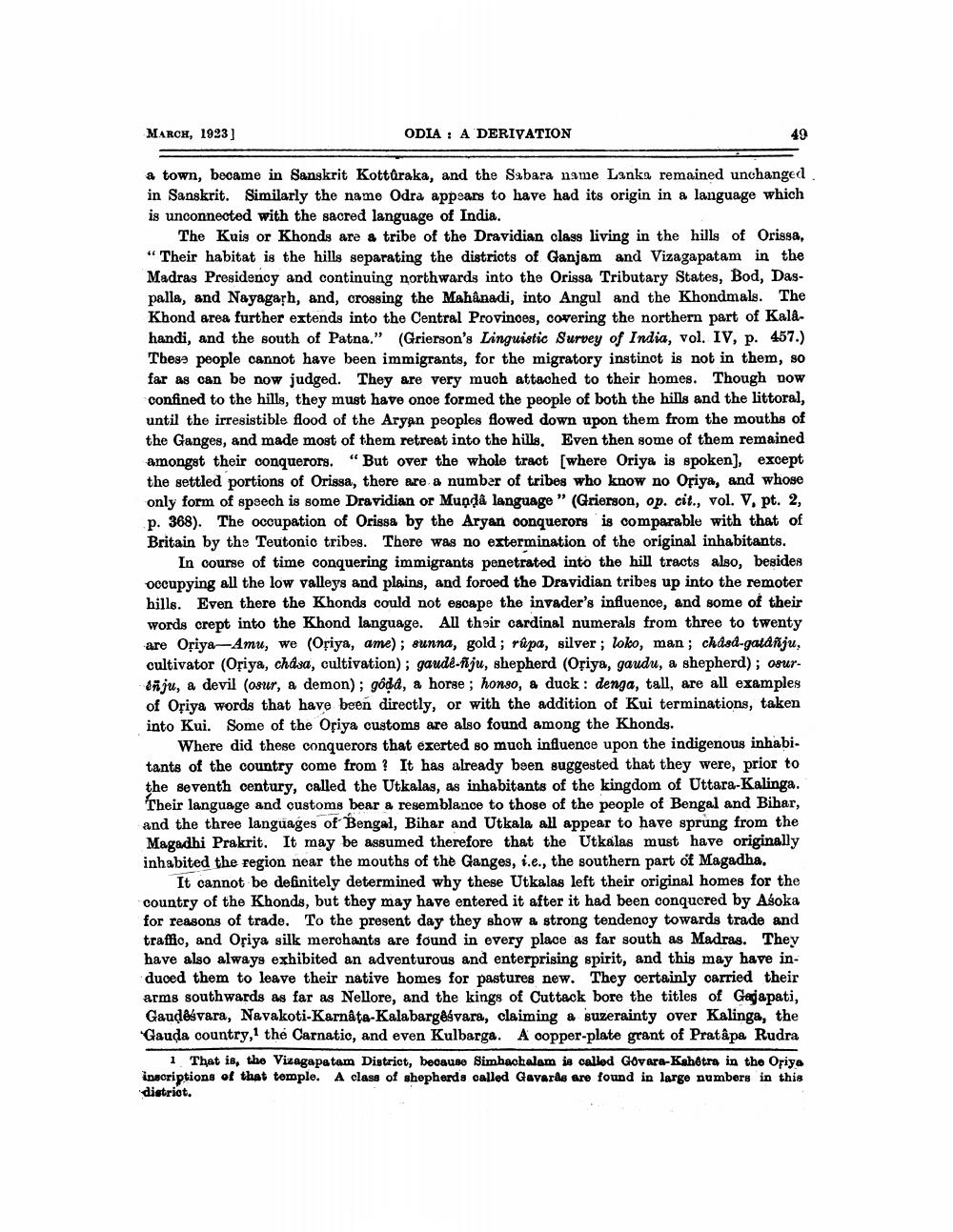________________
MARCH, 1923]
ODIA : A DERIVATION
49
a town, became in Sanskrit Kottäraka, and the Sabara name Lanka remained unchanged in Sanskrit. Similarly the name Odra appears to have had its origin in a language which is unconnected with the sacred language of India.
The Kuis or Khonds are a tribe of the Dravidian class living in the hills of Orissa, "Their habitat is the hills separating the districts of Ganjam and Vizagapatam in the Madras Presidency and continuing northwards into the Orissa Tributary States, Bod, Daspalla, and Nayagarh, and, crossing the Mahanadi, into Angul and the Khondmals. The Khond area further extends into the Central Provinces, covering the northern part of Kaldhandi, and the south of Patna." (Grierson's Linguistic Survey of India, vol. IV, p. 457.) These people cannot have been immigrants, for the migratory instinot is not in them, so far as can be now judged. They are very much attached to their homes. Though now confined to the hills, they must have onoe formed the people of both the hills and the littoral, until the irresistible flood of the Aryan peoples flowed down upon them from the mouths of the Ganges, and made most of them retreat into the hills. Even then some of them remained amongst their conquerors. “But over the whole tract (where Oriya is spoken), except the settled portions of Orissa, there are a number of tribes who know no Oriya, and whose only form of speech is some Dravidian or Mupgå language" (Grierson, op. cit., vol. V, pt. 2, p. 368). The occupation of Orissa by the Aryan conquerors is comparable with that of Britain by the Teutonio tribes. There was no extermination of the original inhabitants.
In course of time conquering immigrants penetrated into the hill tracts also, besides occupying all the low valleys and plains, and foroed the Dravidian tribes up into the remoter hills. Even there the Khonds could not escape the invader's influence, and some of their words crept into the Khond language. All their cardinal numerals from three to twenty are Oriya--Amu, we (Oriya, ame); sunna, gold; rupa, silver ; loko, man; chdsd-gatanju, cultivator (Oriya, chasa, cultivation); gaude-nju, shepherd (Oriya, gaudu, a shepherd); OsurSnju, a devil (osur, a demon); gôda, a horse ; honso, a duck: denga, tall, are all examples of Oriya words that have been directly, or with the addition of Kui terminations, taken into Kui. Some of the Oriya customs are also found among the Khonds.
Where did these conquerors that exerted so much influence upon the indigenous inhabi. tants of the country come from? It has already been suggested that they were, prior to the seventh century, called the Utkalas, as inhabitants of the kingdom of Uttara-Kalinga. Their language and customs bear a resemblance to those of the people of Bengal and Bihar, and the three languages of Bengal, Bihar and Utkala all appear to have sprung from the Magadhi Prakrit. It may be assumed therefore that the Utkalas must have originally inhabited the region near the mouths of the Ganges, i.e., the southern part of Magadha.
It cannot be definitely determined why these Utkalas left their original homes for the country of the Khonds, but they may have entered it after it had been conquered by Asoka for reasons of trade. To the present day they show a strong tendenoy towards trade and traffic, and Osiya silk merchants are found in every place as far south as Madras. They have also always exhibited an adventurous and enterprising spirit, and this may have induced them to leave their native homes for pastures new. They certainly carried their arms southwards as far as Nellore, and the kings of Cuttack bore the titles of Gajapati, Gaudėšvara, Navakoti-Karnata-Kalabargèsvara, claiming a suzerainty over Kalinga, the Gauda country,1 thé Carnatic, and even Kulbarga. A copper-plate grant of Pratâpa Rudra
1. That is, the Vizagapatam District, because Simhachalam is called Govara-Kahetra in the Oriya inscriptions of that temple. A class of shepherds called Gavards are found in large numbers in this distriot.




